On 16 September we will be holding our Annual General Meeting - 2.00pm at SCI HQ. This will be preceded by an open committee meeting at 11.00 am. All members are welcome to attend both meetings.
Earlier in the month, on 8 September, the Professional Horticulture Group South West is visiting Golden Acres Nursery in Dorset to study bedding plant production and nearby Knoll Gardens which specialises in ornamental grasses and uses them to develop low maintenance borders.
Editor
A Bitter Brew
A team of scientists from Argentina, Portugal and the USA have recently identified one of the wild parents of lager yeast (more). Lager yeast is a strain of allotetraploid hybrid yeast, Saccharomyces pastorianus (syn. S. carlsbergensis) believed to be a hybrid between S. cerevisiae and S. bayanus. S. pastorianus is a bottom fermenting yeast which tolerates lower temperatures than Saccharomyces cerevisiae the top fermenting species used to ferment wine and brew beers and it is the slower lower temperature fermentation that gives the characteristic flavour to lager beer. S bayanus is the species used to make cider.
Another component of beer flavour comes from the barley, or more precisely the skill of the maltster in providing the correct conditions to germinate the barley and turn the starch stored in the barley endosperm into sugars that the yeast can then ferment.
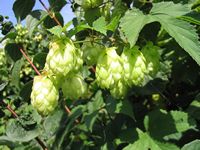
The hop plant is a vigorous perennial climber that grows afresh from its rootstock each year. Its vigour necessitates the extensive permanent support structure of poles and wires that creates the typical hop field or 'hop-yard' . Traditionally hop harvesting was a labour intensive job and the Kent hop harvest was the annual holiday for many East London families. Needless to say machinery has replaced the manual labour.
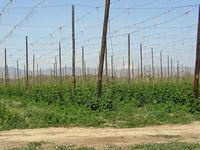
Hop varieties fall into two categories depending on their use in the brewing process. The first class is grown specifically for their alpha acid content. These alpha acids, the most prevalent being humulone, isomerise during the brewing process to become the source of the familiar bitterness of beers. They are usually added at the start of the brew.

The second category are the 'aroma' hop varieties. These usually have much lower alpha acid content but have been selected for the many other flavour components they impart to the brew. Because many of these components would be lost during the brewing process they tend to be added towards the end of the brew. It is the choice of hop varieties and the point at which they are added that decides much of the specific flavour of each beer.
Although traditionally whole hop cones dried in oast houses were delivered to the brewers in 'pockets' which, despite their light-weight name, were large jute sacks weighing around 64kg. Today they are more usually added to the brew as compressed pellets or liquid extract.
Plant of the Month
Hylocereus undatus, red pitaya, scrambling cactus, dragonfruit, Cactaceae
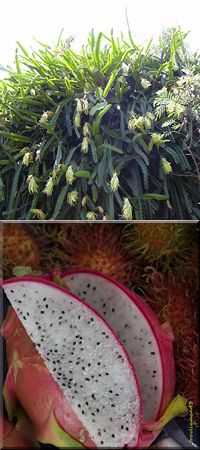
The name hylocereus come from the Greek hyle meaning a wood and cereus meaning cactus. Undatus means waved or wavy.
The pollinated flowers develop into a stunning red fruit, the dragonfruit (picture lower right). The red colour of the flesh is due to plant pigments known as betalains. These only occur in one small part of the plant kingdom - the order Caryophyllales. This order consists of plant families such as Cactaceae, Polygonaceae and Caryophyllaceae. In all other orders in the plant kingdom, the anthocyanin pigment group is present. There have been no instances reported of a plant containing both betalains and anthocyanins. The flesh inside the fruit is white with dark brown seeds. The flesh has a similar texture to Kiwi fruit and the taste is refreshing and mild with no particularly distinctive flavour.
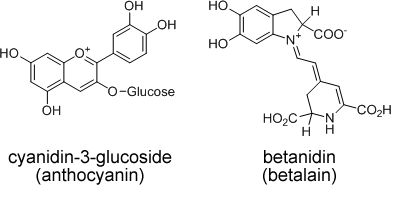
For more information on pigments in Hylocereus sp. see: Pigment pattern and expression of colour in fruits from different Hylocereus sp genotypes, Esquivel, P (Esquivel, Patricia); Stintzing, FC (Stintzing, Florian C.); Carle, R (Carle, Reinhold), Innovative Food Science and Emerging Technologies Volume: 8 Issue: 3 Pages: 451-457 DOI: 10.1016/j.ifset.2007.03.022. Published: Sep 2007
Alison Foster
Oxford Botanic Garden
Medicinal Plant of the Month
Agave sisalana, sisal, Bermuda hemp, Asparagaceae
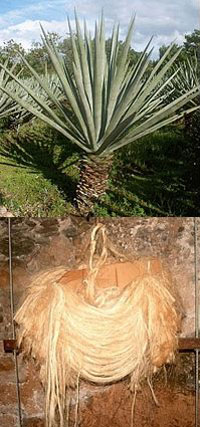
The name agave comes from the Greek agauos meaning admirable - an allusion to the appearance of the plants in flower perhaps? Sisal is a coastal town in the state of Yucatan in Eastern Mexico from where this species originates.
The third update published by the Angiosperm Phylogeny Group in 2009 groups some familiar plant families into superfamilies. Agavaceae was previously treated as a family in its own right but has now become a subfamily of Asparagaceae. This change is due to the availability of new molecular systematic data.
Corticosteroids are a group of steroid hormones normally produced in the adrenal cortex, part of the kidneys. Synthetic asthma drugs in this class include budesonide, betamethasone and beclometasone dipropionate. Cortisone, a natural corticosteroid, can be found in the bile acid of cattle but in the 1950s scientists across the world were racing to be the first to make it from a plant source. Indeed Harper's Magazine described it thus in 1951: 'The new ways of producing cortisone come as the climax to an unrestrained, dramatic race involving a dozen of the largest American drug houses, several leading foreign pharmaceutical manufacturers, three governments, and more research personnel than have worked on any medical problem since penicillin'.
A press conference was held in Mexico City in 1951 to announce the first synthesis of cortisone from a plant source - 11 scientists standing and sitting behind a desk upon which sat a large pile of wild yam (Dioscorea villosa) - the original plant source of diosgenin from which cortisone had been made. Diosgenin can be extracted from other yam species including Dioscorea batatas (Dioscoreaceae).
The breakthrough in cortisone manufacture has led to a multi-million pound industry synthesizing a wide range of pharmaceuticals from steroids. Oral contraceptives and anti-inflammatory drugs are the major players. The annual demand for diosgenin requires roughly 10,000 tonnes of dioscorea tubers. 60% of all steroidal drugs are derived from diosgenin. Other plant sources of diosgenin include Trigonella foenum-graecum (Fabaceae) and Paris polyphylla (Melanthiaceae). Hecogenin is another useful raw material and this is found in Agave sisalana (Asparagaceae, picture top right). This is the same plant that also provides us with sisal fibre (lower right).
Sisal fibre is used to make twine, rope and dartboard and is extracted from the plant in a process known as decortication. Agave sisalana is widely cultivated for fibre production, especially in Tanzania. The entire Tanzanian industry is alleged to derive from a single batch of 62 plantlets introduced in 1893.
Alison Foster
Oxford Botanic Garden
News from our Associates

The CHA is still accepting registrations from companies wishing to exhibit at IPM Essen (24 - 27 Jan 2012) and Fruit Logistica in Berlin (8 - 10 Feb 2012). They will also soon be opening registration for Salon du Végétal in Angers (21 - 23 Feb 2012). Initial interest levels are already good for all three shows but there is still space on the UK pavilion and grants are available at all events for eligible companies.
The CHA has once again recruited a large group of UK companies to exhibit at HortiFair in Amsterdam, 1 - 4 Nov 2011 but there are still one or two spaces remaining on the UK pavilion together with grants of £1,000 towards the costs.

Earlier this year the Society responded to the UK House of Commons Science and Technology Committee inquiry into Peer Review. The Committee has now completed its report. The full report is available here.
Horticulture Industry News
For the very latest horticultural news follow us on Facebook and or
Twitter.
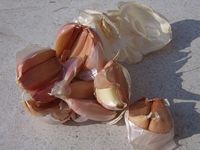
A team led by researchers from Washington State University has found that a group of garlic-derived organosulfur compounds has greater antimicrobial activity than garlic-derived phenolic compounds. 'They demonstrated that diallyl sulfide can freely penetrate bacterial membranes and combine with sulfur containing proteins and enzymes, which is the major antimicrobial mechanism of these organosulfur compounds. Their results demonstrate that the garlic-derived organosulfur compounds have the potential to be used as antimicrobial agents. Campylobacter jejuni, the target microbe in this study, is thought to be the most prevalent cause of bacterial food-borne illness in the world, causing abdominal cramps, fever, and diarrhea accompanied by gross blood and leukocytes.
How plant defences are overcome by pests...
Chewing herbivores evoke characteristic defense responses in plants that are distinguishable from general mechanical damage. In addition, piercing-sucking insects display typical feeding behavior that suggests active suppression of these plant defense responses. Effector chemicals that modulate the plant defenses have been identified in the saliva of these insects. The techniques used have enabled the identification of insect herbivore effectors and their targets that could lead to the development of novel strategies for pest resistance in plants.
...and fungi
Plants depend on their immune system to protect them against diseases. Being able to detect pathogens early on, as well as to kick-start the immune system, especially in the cell wall, is key for ensuring the plant's survival. However a number of pathogens have the capacity to suppress the natural cell wall reaction in plants. Powdery mildew can even reprogramme cells in such a way that they adapt their architecture and metabolism to accommodate the fungus. The plant thus actively fosters the in-growth of the harmful mildew and even supplies it with nutrients.
Two proteins have been identified in barley that control the growth of root hairs. One, called RACB, stimulates the expansion of the plant cell surface during the growth process. The second protein, MAGAP1, is RACB's counterpart, and can either restrict or prevent these activities in the cell. The fungus takes advantage of the RACB protein. One of its roles is to expand the surface of the plant cell membranes but this enables the fungus to proceed with its attack. The absence of the RACB protein helps make the plant become less susceptible to powdery mildew.
Solar power help irrigate third world crops
The Solar Electric Light Fund (SELF), a U.S. non-profit, has introduced an innovative solar-powered drip irrigation system that is helping farmers irrigate their fields. The pilot project launched in partnership with the International Crops Research Institute for the Semi-Arid Tropics (ICRASAT), has installed solar panels in two Benin villages. This provides a cost-effective and environmentally sustainable means of improving food security and raising incomes by providing access to irrigation for small-scale farmers, especially during the six-month dry season. They are able to diversify the crops they grow to include trees and vegetables, like tomatoes and lettuce and increase production ten times.
School of Horticulture for Scotland
The Royal Botanic Garden Edinburgh is in talks with the Scottish Agricultural College to form a partnership that would bring together the research facilities available at SAC with the practical expertise of the RBGE to create a new School of Horticulture. The two institutions would join forces to build on the courses in horticulture and garden design already on offer, as well as creating new courses.
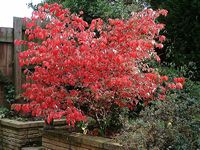
Euonymus alatus, also called 'burning bush' is a popular and widely used ornamental shrub in the USA but also an invasive species and its sale is banned in some States. A triploid seedless variety of has now been created which will enable the species to be used without the risk of it spreading in the wild. Also known as 'winged euonymus' it is a top cash crop for the $16 billion US ornamental plant industry with sales worth tens of millions of dollars each year. The creation of a non-invasive variety should help restore the shrub's prominence in the commercial marketplace. More
Plants took the hard route
Plants of the Solananceae family like pepper, tomato, and potato synthesize a signature set of terpenes for chemical defense against pathogens. Terpenes also provide important compounds for human use including pharmaceuticals. Examples of well-known bioactive terpenes include taxol, which is used to treat certain cancers, and the anti-malarial drug artemisinin. Terpenes are useful as fragrances and flavourings, and their diverse uses have made them the subject of much research looking for novel compounds.
The question is how plants have evolved to make these chemicals. Using modelling techniques researchers have found a disparity between the predicted and natural abundance of terpenes. The common terpenes we see in nature are predicted to be quite rare, based on the chemistry. On the other hand, the terpene forms predicted to dominate are scarcely seen in nature. This suggests an adaptive significance to the distribution of chemicals produced by plants.
New source of Tamiflu precursor
Japanese scientists have discovered that shikimic acid, the compound needed to make the influenza drug Tamiflu, can be extracted and isolated from the leaves of the Ginkgo biloba tree using an ionic liquid. Tamiflu (oseltamir phosphate) hit the headlines in 2005 for its effectiveness against H5N1, the strain of the influenza virus known as bird flu. Tamiflu inhibits neuraminidase - an enzyme that enables the virus to be released from the host cell - and prevents the virus from reproducing.
Oseltamir phosphate is synthesised via a multistep process from shikimic acid which is normally obtained from the spice star anise (Illicium verum). However, a shortage of star anise caused problems a few years ago, when the demand for Tamiflu peaked during the swine flu pandemic in 2009, so new sources are being sought. More
Could mushrooms control TB?
It is claimed that feeding mushrooms to cattle could control the spread of bovine tuberculosis. Compounds found in mushrooms could strengthen the immune systems of cows and helping to stop the spread of bovine tuberculosis between cattle. The company developing the technique says there is sufficient evidence to warrant testing of a fortified mushroom compound which could be delivered to cattle once a year as a bolus. More
Salmonella is more than skin deep
Sanitizing the outside of produce may not be enough to remove harmful food pathogens, according to a Purdue University study that demonstrated that Salmonella and E. coli can live inside plant tissues. They found E. coli present in tissues of mung bean sprouts and Salmonella in peanut seedlings after the plants' seeds were contaminated with the pathogens prior to planting. Seeds could be contaminated in such a manner before or after planting through tainted soil or water. The pathogens were found in every major tissue, including the tissue that transports nutrients in plants. More
Improving parsnips
A recent BBSRC-sponsored knowledge transfer partnership (KTP) has provided Elsoms with the skills and resources needed to implement genetic marker technology within their company, which could reduce the time to market for new parsnip varieties by up to five years. Even with modern seed treatments, Parsnip germination is slow and the seed does not keep well. As a relatively small-scale field crop, it is not top of global seed companies' agenda when it comes to major research investment; so until very recently, the development of new varieties has relied solely on experienced breeders knowing which plants to cross to create new hybrids.
Elsoms Seeds has a large UK market share in the parsnip seed business but wanted to improve breeding methods using marker technology in order to remain competitive. This approach could offer an alternative to assessing offspring plants purely by their appearance (which is very time-consuming). Instead plants are screened in the lab for a genetic marker - a piece of DNA - that indicates the presence of the trait that the breeder is trying to select for.
Botany is officially 'hot' (or even 'really cool'…)
Clive Cookson writing in the Financial Times magazine lists 'plants to feed the world' amongst his 'Science's 10 hottest fields'. Musing on the projected global population increase from 7 billion later in 2011 to 9 billion mid-21st century, Cookson argues for a major role of both GM (genetic modification) of crops and use of conventional breeding technologies to develop crops to feed the burgeoning population. More
Deeper roots could lower atmospheric carbon
Breeding crops with roots a metre deeper in the ground could lower atmospheric CO2 levels dramatically, with significant environmental benefits. Although the amount of carbon presently sequestered in the soil has been known for some time, a new analysis is the first to reveal the benefits to the environment that might come from breeding novel crops with root traits designed to enhance carbon sequestration.
Professor Kell, Professor of Bioanalytical Science at the University of Manchester has devised a carbon calculator that can show the potential benefits of crops that burrow more deeply in the ground. He has calculated that breeding crops that had roots a metre deeper in the soil could double the amount of carbon captured from the environment. The soil represents a reservoir that contains at least twice as much carbon as does the atmosphere, yet mainly just the above-ground plant biomass is harvested in agriculture, and plant photosynthesis represents the effective origin of the overwhelming bulk of soil carbon. More
English elm returns to Leicestershire

Some 23 years later, it seems the nursery owner may have cracked the secret of how to reintroduce to the countryside the species that was immortalised on canvas by John Constable in The Hay Wain (picture right). Mr King has produced 2,000 healthy English Elm (Ulmus procera) saplings from the original pair of 200-year-old disease-resistant trees. Customers include the Royal Botanic Gardens at Kew and Leicestershire County Council. The Leicestershire Elm Project has established 60 of the trees in the county's schools and The National Forest. More and More
Satellites help separate Grand Crus from Vin de Table
In recent days, satellite-borne cameras have been circling French vineyards taking multispectral snaps from more than 500 miles above the Earth at the rate of 1,000 plots every eight seconds. These can detect the surface area and variation of leaf canopy across vineyards - a vital statistic to pinpoint the vigour of particular vines, the water level of soil, bunch and grape weight, and the presence of certain minerals. It can also help spot diseases.
The satellites began mapping this detailed data at the period of véraison, the moment the berries begin to ripen, swell and change colour. This takes place in July and roughly three to four weeks before grape harvest. Wine growers provide data on their fields and a few details about their vines and grape variety. When the time is right, the satellites then take pictures, which are turned into multicoloured maps. These allow them to determine when grapes are mature for harvesting and variations in grape quality within plots, meaning growers can separate out lower-grade bunches for vin de table and keep the best for higher end grands crus. More
GM plants could help prevent HIV etc.
An antiviral drug synthesised by genetically modified plants is being tested on a small number of women in the UK to establish its safety, bringing closer the possibility of cheap modern medicines for the developing world. The drug's developers hope it can be used to prevent HIV infection, but the real breakthrough is that the research demonstrates it is possible for similar molecules - known as monoclonal antibodies - to be produced relatively cheaply in plants to the high standards needed for their use in humans.
Pharma-Planta is a project launched seven years ago with the objective of using GM plants to slash the cost of drugs that are hard to produce. The scientists' aim is to increase the availability of these modern medicines - which are often highly effective - in the poorest countries of the world. More
Quote of the Month
'It is the unknown that makes science interesting'
Sir Alec Jeffreys
Events Calendar
Four Oaks Trade Show
4 - 6 Sep
Lower Withington, UK
Spoga Gafa Trade Fair
4 - 6 Sep, Koelnmesse
Cologne, UK
Saltex
6 - 8 Sep, Institute of Groundsmanship
Windsor, UK
Mycotoxins in Nuts and Dried Fruits
10 - 12 Sep, International Society for Horticultural Science
Damghan, Iran
Fruit Breeding and Genetics
11 - 15 Sep, International Society for Horticultural Science
Warsaw, Poland
Genetically Modified Organisms in Horticulture Symposium
11 - 15 Sep, Eucarpia
Mpumalanga, South Africa
European Whitefly Symposium
11 - 16 Sep, The Hebrew University of Jerusalem, Tel Aviv University and Volcani Center
Rehovot, Israel
Flormart
15 - 17 Sep, PadovaFiere
Padova, Italy
Naivasha Horticultural Fair
16 - 17 Sep
Naivasha, Kenya
Integrated Control in Protected Crops, Temperate Climate
18 - 22 Sep, Association of Applied Biologists
Sutton Scotney, UK
In Vitro Culture and Horticultural Breeding
18 - 22 Sep, International Society for Horticultural Science
Ghent, Belgium
Exocytosis in animals, fungi and plants
19 - 21 Sep, Society of Experimental Biology
London, UK
Biomass and Energy Crops
21 - 23 Sep, Association of Applied Biologists
Champaign, USA
IPM Dubai
26 - 26 Sep, Messe Essen
Dubai, UAE
Technical visit to Warburtons
2 Oct, Institute of Food Science and Technology
Enfield, UK
Meet the staff
3 Oct, Oxford Botanic Garden
Oxford, UK
South West Growers Show
5 Oct, South West Growers
Exeter, UK
Balkan Symposium on Vegetables and Potatoes
9 - 12 Oct, International Society for Horticultural Science
Tirana, Albania
ProMusa International Symposium
10 - 14 Oct, International Society for Horticultural Science
Salvador, Brazil
The Application of Nanotechnology in the Food and Food Packaging Industries
11 Oct, Institute of Food Science and Technology, Institution of Mechanical Engineers
London, UK
New technologies for early pest and disease detection
12 Oct, Association of Applied Biologists
Marston, UK
High Tunnel Horticultural Crop Production
16 - 19 Oct, International Society for Horticultural Science
Pennsylvania, USA
Acclimatization and Establishment of Micropropagated Plants
16 - 20 Oct, International Society for Horticultural Science
Nebraska City, USA
Growing Media, Composting and Substrate Analysis
17 - 21 Oct, International Society for Horticultural Science
Barcelona, Spain
Biofumigation and Biopesticides Symposium
18 - 20 Oct, Ag-West Bio
Saskatoon, Canada
National Fruit Show
19 - 20 Oct, The Marden Fruit Show Society
Detling, UK
A healthy, wealthy, sustainable world
20 Oct, Oxford Botanic Garden
Oxford, UK
Colour in the garden
27 Oct, Oxford Botanic Garden
Oxford, UK
CropWorld Global
31 Oct - 2 Nov, British Crop Protection Council
London, UK
Hortifair
1 - 4 Nov, Amsterdam RAI
Amsterdam, The Netherlands
Scotsturf
2 - 3 Nov, Institute of Groundsmanship
Edinburgh, UK
Postharvest and Quality Management of Horticultural Products of Interest for Tropical Regions
2 - 4 Nov, International Society for Horticultural Science
Bogota, Colombia
Pyrethrum, The Natural Insecticide
2 - 4 Nov, International Society for Horticultural Science
Hobart, Australia
Southern Growers Exhibition
9 Nov, Southern Growers
Chichester, UK
International Symposium on Date Palm
13 - 14 Nov, International Society for Horticultural Science
Algiers, Algeria
International Symposium on Tropical Wines
14 - 16 Nov, International Society for Horticultural Science
Chiang Mai, Thailand
Medicinal and Aromatic Plants
15 - 18 Nov, International Society for Horticultural Science
Chiang Mai, Thailand
World Fruit and Vegetable Expo
16 - 17 Nov, WVF Expo
London, UK
Management of Tuta absoluta
16 - 18 Nov, EPPO/IOBC/FAO/NEPPO
Agadir, Morocco
Onion and Carrot Conference
16 - 17 Nov, Processed Vegetables Growers' Association
Peterborough, UK
Epigenetics and Tomato Improvement
17 Nov, Society of Biology
Sutton Bonnington, UK
Medicinal and Aromatic Plants
20 - 23 Nov, International Society for Horticultural Science
Antigua, Guatemala
Symposium on New Floricultural Crops
22 - 25 Nov, International Society for Horticultural Science
Buenos Aires, Argentina
IAgrM BIAC National Conference
23 Nov, British Institute of Agricultural Consultants
Details to Follow
Trees - A cut above the rest
24 Nov, Oxford Botanic Garden
Oxford, UK
Symposium on Papaya
24 - 27 Nov, International Society for Horticultural Science
Chiang Mai, Thailand
Frontiers of Citrus
27 - 30 Nov, International Society for Horticultural Science
Tel Aviv, Israel
Biopesticide International Conference
28 - 30 Nov, Journal of Biopesticides
Palayamkottai, India
Biopesticides
29 Nov, Association of Applied Biologists
Marston, UK
Symposium on Tropical and Subtropical Fruits
29 Nov - 2 Dec, International Society for Horticultural Science
Chiang Mai, Thailand
Advances in Biological Control
30 Nov, Association of Applied Biologists
Marston, UK
If you would like to advertise a forthcoming event please contact. zoe.daniel@soci.org
Horticulture Group Contact Details
For submitting ideas or to volunteer to be part of a committee or a group, please contact:
Chairman - Peter Grimbly
Meetings Secretary - Marion Stainton
Minutes Secretary - Margaret Waddy
Newsletter Co-ordinator - Sue Grimbly, E: scihortigroup@btinternet.com
Group Coordinator - Zoe Daniel zoe.daniel@soci.org T: +44 (0)20 7598 1594
